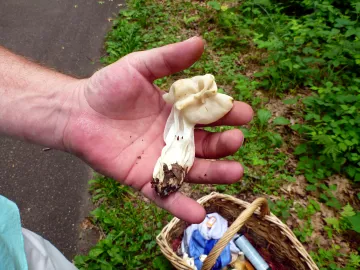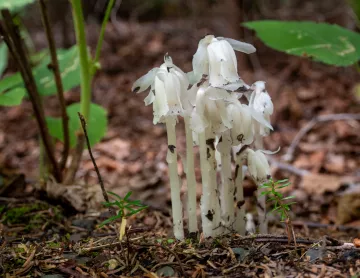Bob Suchanek, Water and Wetlands Steward

Elfin Saddle (Helvella sp.) – A Web Component
Photo Credit: Bob Suchanek

Ghost Pipe (Monotropa uniflora) – A Web Hacker
Photo Credit: Steve Ring
Connecting the Web
Ecology describes the study of the relationships between organisms and their environments: both the places where they live and the thicket of relationships that sustain them. – Merlin Sheldrake
A forest ecosystem is a connected web of relationships built on the underground entanglement of plant roots and the filaments of fungi; a symbiosis in which different species live in physical contact. In 1997 Suzanne Simard published a paper in which she demonstrated how this relationship made it possible for birch trees to pass supplemental carbon (food) to shaded fir trees. In commenting on this work, British researcher Dr. David Read created a cover story for the journal Nature: “The Wood Wide Web.”
There are many different kinds of fungi (yeasts, mildews, molds, mushrooms and more) but the fungi of the forest network are unique in their plant root affinity; a fungus/root relationship called mycorrhizal. There are two mycorrhizal specializations: fungi that enfold the outside of plant roots (ectomycorrhizal) and fungi that penetrate plant roots (endomycorrhizal). This arrangement often benefits both the fungus that gets carbon from the plant and the plant that gets nitrogen and phosphorous from the fungus.
Hacking the Web
I remember the first time I saw the “ghost pipe.” This strangely attractive plant seemed to defy my notions of what a proper woodland flower must be. At the time I think this exotic member of the heath family was considered to be saprophyte, living directly off of decaying organic matter. Now it’s more accurately understood to be a parasite that derives it’s nutrition from the fungal web.
Life Beyond the Web
We are symbionts on a symbiotic planet, and if we care to, we can find symbiosis everywhere. – Lynn Margulis
Finding a cooperative balance with nature in a culture of competition is challenging but it seems like a Sierra Club sort of thing. The Wood Wide Web is an amazing example of interests merged for a common good.
Some Sources:
https://www.spun.earth/networks/mycorrhizal-fungi
Simard Suzanne, et al. “Net transfer of carbon between ectomycorrhizal tree species in the field”, Nature, 388, 579-582 (1997)
Sheldrake, Merlin. 2020. Entangled Life: How Fungi Make Our Worlds, Change Our Minds, & Shape Our Futures. New York, NY: Penguin Random House LLC.
Margulis, Lynn. 1998. Symbiotic Planet. New York, NY: Basic Books, A Member of the Perseus Books Group